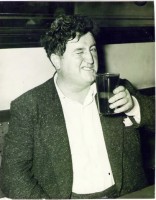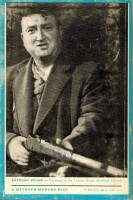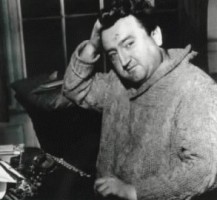
The Great Brendan Behan
Alan Finn Reminds us at the 50th anniversary of “The Borstal Boy” of the great writer and wit that was Brendan Behan
Ireland, the island nation renowned the world over as the land that gave birth to some of the world’s greatest bards and storytellers. To be honest, I would simply be eating into an already over extended word count with this article to list the most prominent here. Our focus is the history of one of the most outspoken children of Dublin, to coincide with the 50th anniversary production of “The Borstal Boy”, the man himself Brendan Behan.
Brendan Francis Behan was born in Holles Street Hospital Dublin on the 9th of February 1923. The first of his parents’ five children, Brendan’s upbringing was steeped in Irish history and culture, which emphasised Irish storytelling and traditional ballad songs. His parents lived in a house in Russell Street (not far from Mountjoy Square), which was owned by Brendan’s grandmother, Christine English, who had several houses in the area.
The Behan family was very much a republican family, Brendan’s father, Stephen, played an active role in the War of Independence. Brendan’s uncle Peadar Kearney had written the original English words to the Irish National anthem, “The Solder’s Song. Their mother, Kathleen, also, played her part in the War of Independence, acting as a courier delivering letters to and from various points in and around the city. The Behan’s artistic side was cradled by their mother who spent time bringing them on literary tours of Dublin.
At the age of 13, Brendan left school, and began his apprenticeship of becoming a painter and decorator, following in the steps of his father. Around this time he began his first writings, starting with a short story titled “The Laughing Boy “, which he dedicated to the revolutionary leader, Michael Collins. It’s believed that Michael was a family’s friend, and a very close friend to Kathleen Behan. By the age of 14, Brendan had joined a youth Republican movement called “Fianna Eireann” an organisation ran by the IRA.
Brendan became heavily involved in the Republican movement, whilst travelling to Manchester at the young age of 16, he was stopped at Liverpool Docks and was arrested after the authorities found bomb making materials in his suitcase. As he was below the age of 18, he was sent to Hollesley Bay Borstal Prison for 3 years. While he was there, Brendan took full advantage of the prison’s library and fed his love of reading. His experiences would become the inspiration for one of his most famous works “The Borstal Boy”.

Brendan’s life in England softened his opinions on the old enemy and he grew to realise that working class Catholics and working class Protestants had more in common than he first perceived.
However, his new found socialism did not dissuade him from fighting for the Republican cause and upon his return to Ireland after his three year stay at her majesty’s pleasure, he was arrested and sentenced to 14 years in prison for his involvement in a plot to kill two Irish Garda. He was sent first to Mountjoy Prison then to the Curragh Camp in Kildare.
In 1947, his short found freedom was ended after he was returned to custody for a short period of time after he was caught trying to break free a fellow IRA member who was in a Manchester Prison. This was to be the ending of Brendan’s involvement with Republicanism. While inside Brendan taught himself how to speak Irish, and he subsequently, wrote and produced his first play titled “The Landlady”, during this period he was also beginning to get a number of short stories published.
Under a general amnesty to all republicans by De Valera, in 1946, Brendan was released from prison. Over the next few years, he divided his time living in Dublin City, Connemara, and once briefly in Paris. Brendan was writing and painting houses to help pay his bills.
In 1954, his Magnus opus “The Quare Fellow” was staged in the Pike Theatre in Dublin. The play used “Mountjoy Prison” as the inspiration for his setting. It was about a man who was to be hung for murder. The play followed the last night and day in the prison before he was to be hung. The play got a good 6 month run at the theatre before it was picked up and brought to London by Joan Littlewooods “Theatre Royal”, in Stratford, East London. Brendan’s star began to rise, famously appearing on a BBC interview with Malcolm Muggeridge, drunk, as he said himself, he was a drinker with a writing problem.

By this stage, our troubled genius was married to Beatrice Salkeld, the daughter of the painter Cecil Salkeld, he married Beatrice in a Catholic church in secret in 1955. After the famous Muggeridge interview, Brendan was never far out of the media and he happily played his role as the drunken Irish man.
The Quare Fellow had begun a long run on Broadway, and it was said Brendan fell in love with New York. He once said it felt like home from home. Brendan’s next major work was in Irish, titled “An Gail”, it was commissioned by Gael Linn. It was first performed in Dublin’s Damer Theatre, it tells the story of a British soldier been held by the IRA, in the run up to the planned execution of an Republican volunteer, in the north of Ireland. He then translated the play in to an English version and again it was brought over to East London by Littlewoods Production Company, now titled “The Hostage”. Unsurprisingly, it was a massive success in both London and New York, this drunk Irishman had a brain.
Brendan began to develop health problems he was diagnosed with diabetes in 1956, which at times caused him to have seizures and comas.
In 1963, he became a dad for the first time to his daughter Blathnaid. Although, he doted on his daughter he couldn’t stop drinking. Now a huge star in his own right’s and money coming steadily in, Brendan became a frequent visitor to pubs where ever he went. After years of heavy drinking, seizures, Brendan collapsed in a Dublin pub called “The Harbour Lights” on March 20th, 1964. Brendan was only 41 years old when he died. He is buried in Glassnevin Cemetery, the headstone has a special crevice designed into it for people to place a pint, when they visit. Gravediggers’ pub being a little far to travel when you are 6 feet under! Thousands of people lined the streets of Dublin to pay their last respect to this wonderful writer as his procession passed them for the final time…….









Behan was tutored by Séan Ó Briain, a schoolmaster from Ballyferriter in the Kerry Gaeltacht who taught him Irish, whilst in Mountjoy Jail.
When Behan was placed in continuing detention at the Curragh Internment camp, he embarked on a serious study of the Irish language under the guidance of Máirtín Ó Cadain.
Your piece makes it sound as though Behan picked up a book and taught himself the language!
You did not refere at all to his poetry!
An omission on our part and you are quite correct, however, ease of reading does and accessibility do require some level of summation, I hope you can understand this position.
All the best and thank you for your interest
Eoghan Brunkard
Website Manager